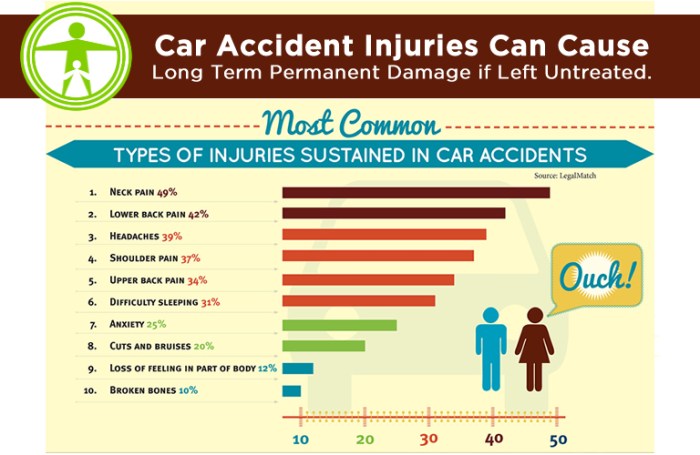Car accidents can range from minor fender-benders to catastrophic events, leaving victims with a spectrum of injuries. Understanding the types of car accident injuries, their severity, and potential long-term effects is crucial for both prevention and recovery. This guide equips you with the knowledge to navigate the aftermath of a car accident.
Types of Car Accident Injuries
The force and speed of impact, vehicle types involved, and body parts struck all influence the type and severity of injuries sustained in a car accident. Injuries can range from minor to life-threatening, and some may not be immediately apparent. Seeking medical attention after an accident is vital, even if you feel unharmed.
-
Head Injuries:
- Concussion: A mild traumatic brain injury (TBI) causing headaches, nausea, vomiting, and confusion.
- Skull Fracture: A break in the skull leading to bleeding, bruising, and brain swelling.
- Traumatic Brain Injury (TBI): A serious brain injury with a wide range of symptoms, including coma, paralysis, and death.
-
Neck Injuries:
- Whiplash: A neck injury caused by a sudden, forceful back-and-forth head movement.
- Neck Strain: A muscle or ligament injury in the neck.
- Neck Fracture: A break in one or more cervical vertebrae.
-
Back Injuries:
- Back Strain: A muscle or ligament injury in the back.
- Back Sprain: A ligament injury in the back.
- Herniated Disc: A condition where the disc’s soft center pushes through the tough outer layer.
-
Chest Injuries:
- Broken Ribs: A fracture in one or more ribs.
- Pneumothorax: A collapsed lung.
- Hemothorax: A collection of blood in the chest cavity.
-
Abdominal Injuries:
- Blunt Abdominal Trauma: An injury to the abdomen caused by a blow or impact.
- Penetrating Abdominal Trauma: An injury caused by a sharp object like a knife or bullet.
- Ruptured Spleen: A tear in the spleen, an organ filtering blood.
-
Pelvic Injuries:
- Pelvic Fracture: A break in one or more pelvic bones.
- Pelvic Hematoma: A collection of blood in the pelvis.
- Urethral Injury: An injury to the urethra, the tube carrying urine from the bladder.
-
Extremity Injuries:
- Broken Bones: Fractures in the arms or legs.
- Dislocation: A joint injury where bones are forced out of alignment.
- Amputation: Loss of a limb or part of a limb.
Severity and Long-Term Effects
Car accident injury severity can vary significantly. Some injuries heal quickly, while others cause permanent disability or death. It’s crucial to seek medical attention promptly for proper diagnosis and treatment.
Legal Considerations After a Car Accident
Understanding your legal rights and responsibilities following a car accident is essential. This knowledge empowers you to protect your interests and seek compensation for your injuries.
- Seeking Medical Attention: Prompt medical attention after a car accident is vital to document injuries for insurance and legal purposes.
- Filing Insurance Claims: Notify your insurance company promptly and provide them with a detailed account of the incident, supporting documentation, and medical bills.
- Legal Representation: Consider legal representation if your claim is denied or the settlement offered is inadequate. An attorney can navigate the legal process, negotiate with the insurance company, and file a lawsuit if necessary.
Support and Resources Available
Car accident victims face numerous challenges. Fortunately, various resources and organizations can provide support and assistance:
-
Medical Professionals: Physicians, surgeons, neurologists, physical therapists, and occupational therapists play crucial roles in treating injuries and helping regain mobility and independence.
-
Rehabilitation Specialists: Speech therapists, cognitive rehabilitation therapists, and vocational rehabilitation counselors can assist with speech, memory, problem-solving, and returning to work.
-
Support Groups: Organizations like MADD (Mothers Against Drunk Driving), NAMI (National Alliance on Mental Illness), and support groups specific to injuries can provide a sense of community and shared experiences.
-
Financial Assistance: Health insurance, disability insurance, and government assistance programs may offer financial support depending on eligibility.
-
Legal Aid: Personal injury attorneys and legal aid organizations can offer legal representation or low-cost legal services.
Conclusion: Prioritizing Safety and Recovery
Car accident injuries can have a profound impact on a person’s life. Understanding the types of injuries, their severity, and available resources empowers individuals to be better prepared. By prioritizing road safety and responsible driving practices




